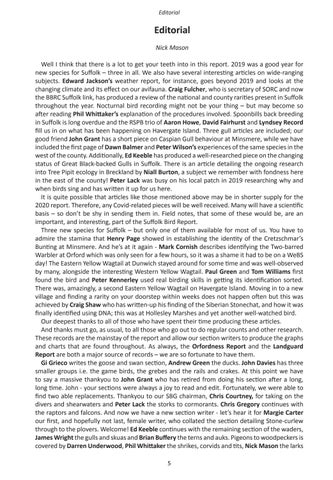Editorial
Editorial Nick Mason Well I think that there is a lot to get your teeth into in this report. 2019 was a good year for new species for Suffolk – three in all. We also have several interesting articles on wide-ranging subjects. Edward Jackson’s weather report, for instance, goes beyond 2019 and looks at the changing climate and its effect on our avifauna. Craig Fulcher, who is secretary of SORC and now the BBRC Suffolk link, has produced a review of the national and county rarities present in Suffolk throughout the year. Nocturnal bird recording might not be your thing – but may become so after reading Phil Whittaker’s explanation of the procedures involved. Spoonbills back breeding in Suffolk is long overdue and the RSPB trio of Aaron Howe, David Fairhurst and Lyndsey Record fill us in on what has been happening on Havergate Island. Three gull articles are included; our good friend John Grant has a short piece on Caspian Gull behaviour at Minsmere, while we have included the first page of Dawn Balmer and Peter Wilson’s experiences of the same species in the west of the county. Additionally, Ed Keeble has produced a well-researched piece on the changing status of Great Black-backed Gulls in Suffolk. There is an article detailing the ongoing research into Tree Pipit ecology in Breckland by Niall Burton, a subject we remember with fondness here in the east of the county! Peter Lack was busy on his local patch in 2019 researching why and when birds sing and has written it up for us here. It is quite possible that articles like those mentioned above may be in shorter supply for the 2020 report. Therefore, any Covid-related pieces will be well received. Many will have a scientific basis – so don’t be shy in sending them in. Field notes, that some of these would be, are an important, and interesting, part of the Suffolk Bird Report. Three new species for Suffolk – but only one of them available for most of us. You have to admire the stamina that Henry Page showed in establishing the identity of the Cretzschmar’s Bunting at Minsmere. And he’s at it again - Mark Cornish describes identifying the Two-barred Warbler at Orford which was only seen for a few hours, so it was a shame it had to be on a WeBS day! The Eastern Yellow Wagtail at Dunwich stayed around for some time and was well-observed by many, alongside the interesting Western Yellow Wagtail. Paul Green and Tom Williams first found the bird and Peter Kennerley used real birding skills in getting its identification sorted. There was, amazingly, a second Eastern Yellow Wagtail on Havergate Island. Moving in to a new village and finding a rarity on your doorstep within weeks does not happen often but this was achieved by Craig Shaw who has written-up his finding of the Siberian Stonechat, and how it was finally identified using DNA; this was at Hollesley Marshes and yet another well-watched bird. Our deepest thanks to all of those who have spent their time producing these articles. And thanks must go, as usual, to all those who go out to do regular counts and other research. These records are the mainstay of the report and allow our section writers to produce the graphs and charts that are found throughout. As always, the Orfordness Report and the Landguard Report are both a major source of records – we are so fortunate to have them. Gi Grieco writes the goose and swan section, Andrew Green the ducks. John Davies has three smaller groups i.e. the game birds, the grebes and the rails and crakes. At this point we have to say a massive thankyou to John Grant who has retired from doing his section after a long, long time. John - your sections were always a joy to read and edit. Fortunately, we were able to find two able replacements. Thankyou to our SBG chairman, Chris Courtney, for taking on the divers and shearwaters and Peter Lack the storks to cormorants. Chris Gregory continues with the raptors and falcons. And now we have a new section writer - let’s hear it for Margie Carter our first, and hopefully not last, female writer, who collated the section detailing Stone-curlew through to the plovers. Welcome! Ed Keeble continues with the remaining section of the waders, James Wright the gulls and skuas and Brian Buffery the terns and auks. Pigeons to woodpeckers is covered by Darren Underwood, Phil Whittaker the shrikes, corvids and tits, Nick Mason the larks 5














